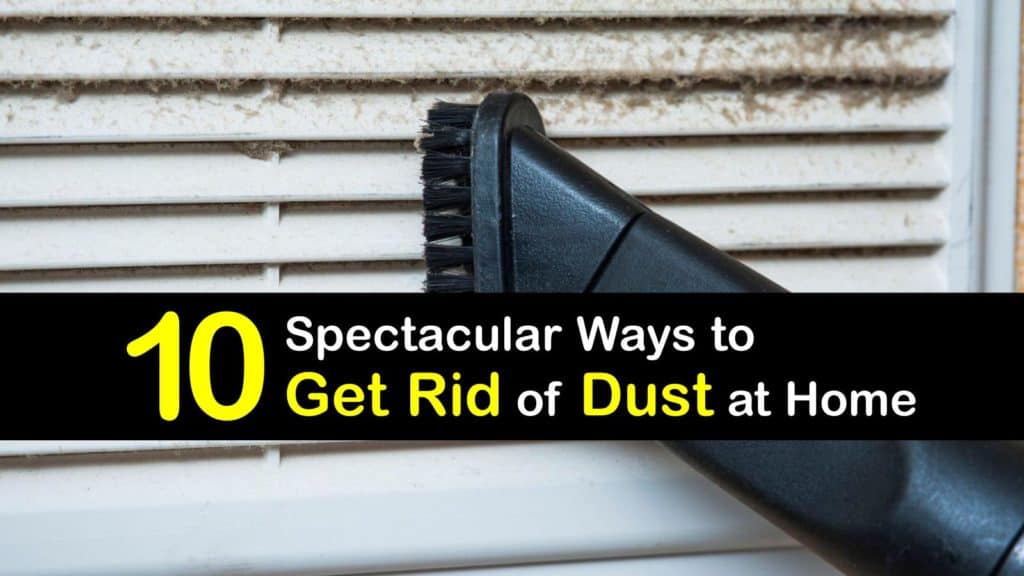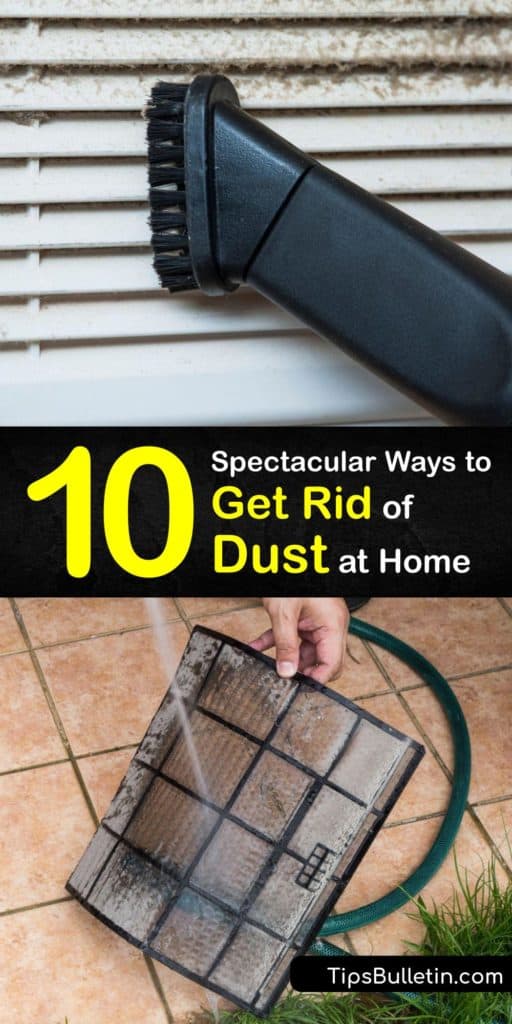Does housecleaning sometimes feel like a constant battle with dust? Read on to learn how to get rid of dust around your house and what steps to take to cut down on the amount of dust present in the first place.
Household dust consists mainly of tiny fabric fibers, carpet fluff, dead skin cells, animal dander if you have pets, and dirt tracked in from outdoors. Over time, these dust particles build up on baseboards, bookshelves, countertops, decorations, floors, furniture, and other surfaces around the house.
Dust bunnies are often a source of airborne allergens around the home. Keeping your home dust-free to maintain healthy air quality is essential for those who suffer from allergies, asthma, or other respiratory problems.

- Best Ways to Get Rid of Dust at Home
- How to Get Rid of Dust by Improving Your HVAC System
- Use an Air Purifier to Cut Down on Household Dust
- Install a Humidifier
- Rethink Your Closet Storage for Clothing and Linens
- Getting Rid of Dust with Proper Vacuuming
- Switch from Carpet to Hardwood Floors
- Invest in Doormats
- Pet Hygiene
- Regularly Clean Furniture and Upholstery
- Best Types of Dusters
Best Ways to Get Rid of Dust at Home
By taking the following simple steps, you’ll be able to minimize the dust buildup around your home and make your weekly house cleaning schedule a breeze. Getting rid of dust doesn’t have to be a struggle after making these easy changes around your home.
The best way to get rid of dust around your house and tackle the dust particles build up on baseboards and other interior areas depends on the main contributing factors.
Some considerations are if you have pets at home, whether or not your family and guests remove their shoes indoors, and how your HVAC (heating, ventilation, and air conditioning) system is set up.
A frequent and sometimes aggravating side effect of household dust buildup is allergen-spreading dust mites. They’re tiny arachnids that feed on dead skin cells and commonly inhabit area rugs and carpeting, mattresses, upholstery, and hidden crevices.
Dusting and vacuuming regularly reduce the presence of dust mites. Still, to effectively combat the problem, it’s essential to lessen the overall amount of dust buildup.
By making a few straightforward adjustments around your home, you’ll enjoy better air quality and have an easier time keeping things looking neat and tidy. Use the following home remedies to get rid of dust and get rid of dust mites quickly and easily.
How to Get Rid of Dust by Improving Your HVAC System
Your home’s HVAC system has a tremendous impact on the amount of dust that accumulates. It’s critical to change the air filters and furnace filter monthly for optimum performance.
If your house has an outdoor condenser unit, give it a deep clean twice per year in the spring and autumn.

If you don’t have air conditioning, consider installing ceiling fans to circulate fresh air throughout the house. Especially if it’s windy, resist opening windows and doors to avoid letting in dust from outdoors.
Especially for people who deal with allergies, asthma, and other respiratory conditions, it’s highly beneficial to install a HEPA (high-efficiency particulate absorbing) filter instead of a regular air filter.
A HEPA filter forces air to flow through a fine mesh of glass fibers and activated carbon to filter out harmful and irritating contaminants like dirt, pet dander, pollen, smoke, and more.
Use an Air Purifier to Cut Down on Household Dust
Depending on your budget, air purifiers are available as whole-house units or smaller, portable single-room devices. An air purifier system is one of the most economical and efficient ways to get rid of dust at home.
In most cases, an air purifier uses a fan to force air through a filter, which traps dust and other air pollutants. Some air purifiers also sanitize the air with UV light to kill any bacteria, mold, and viruses that might be present before releasing it back into the room.
Some types of air purifiers also feature electrostatic technology. When dust particles enter the device, they receive an electric charge that makes them adhere to the filter more easily.
Install a Humidifier
Dry air leads to more dust. It also leaches moisture from indoor furnishings and may cause paint to flake more easily. Dry skin sheds more dander, which is true for both humans and pets.
Just like air purifiers, humidifiers are also available as whole-house installations or lightweight, movable appliances.
Another added benefit of using a humidifier is reducing the amount of static electricity present in your home. Static causes dust particles to cling to clothing, furniture, and other household surfaces.
Rethink Your Closet Storage for Clothing and Linens
A large portion of household dust comes from fabric fibers shed from clothing, linens, and upholstery. To minimize dust buildup in your closets, consider storing seasonal clothing in vacuum-sealed garment bags while you’re not using them.
Keep your closet shelves and hangers decluttered, and make sure it’s not crammed too full to dust regularly.
Not only does bedding shed fabric fibers, but it also collects dead skin cells. Be sure to launder all of your linens weekly and wash your blankets and mattress cover at least once per month.
Even though your pillowcases might be frequently laundered, bed pillows also accumulate dust particles and sometimes even dust mites. Wash or dry clean your pillows every few months.
Getting Rid of Dust with Proper Vacuuming
Vacuuming is one of the easiest and quickest ways to get rid of dust at home. To prevent excess dust buildup, vacuum all of the floors in your house thoroughly once per week.
If you have persistent problems in high-traffic areas, you may need to vacuum more often. An incredibly convenient solution to the necessity of vacuuming is to purchase an automatic or robotic vacuum.
They generate less noise than traditional vacuums and have sensors to prevent damage to the device or your furniture.
Another solution is to install a central vacuum system in your home. They’re also sometimes referred to as a whole-house vacuum.
The appliance features hidden pipes around baseboards throughout the house that suck dust and other contaminants down to a large canister in the basement. The systems are generally low-maintenance and simple to install.
Switch from Carpet to Hardwood Floors
Modern homeowners have come to a common consensus: hardwood floors are much easier to keep clean. Carpeting collects large amounts of dust, only to send it flying into the air every time you walk around.
Over time, the carpet pad accumulates dirt and grime that even the best vacuum cleaners and carpet treatments can’t eliminate.
Replacing your carpets with hard flooring allows you to keep the dust levels in your home lower. It also gives your interior a modern, polished look.
Make a simple floor cleaner to use after vacuuming and sweeping your floors to keep them shiny and reduce the amount of dust and dirt.
Invest in Doormats
Trap dirt at the door by using bristle-top doormats. Roughly 60% of house dust is tracked in from outdoors. Placing a doormat on both the interior and exterior of your doorways helps to prevent dirt from traveling farther inside when people enter your home.
It’s also a good idea to ask your family and guests to remove their shoes at the door.
To avoid having a footwear pile in your entryway, try placing a shoe rack in a convenient location for your family and guests to place their shoes on. Doing so keeps things organized and traps dirt from shoes for easy cleanup.
Pet Hygiene
Our beloved pets add endless amounts of enrichment, entertainment, and love to our lives. However, they also come with a considerable mess to clean up after.
Pet dander or the hair and dead skin cells they shed is a major contributing factor to household dust buildup. Bathe and groom your pets consistently to keep their shedding minimal.
Doing so outdoors keeps the mess out of your house. If that’s not possible, groom your pet over an old towel in your bathroom. When you finish, shake the towel off outdoors or out a window before laundering it.
Using a covered litter box with a door flap helps to contain the dust and mess from kitty litter for cat owners.
It also gives your feline friends a sense of privacy to do their business, which sometimes minimizes their instinct to dig and bury their waste. However, not all cats feel the same about it, and some cats refuse to use enclosed litter boxes.
Regularly Clean Furniture and Upholstery
Vacuuming isn’t just for your floors. It’s also an excellent way to get-rid-of-dust trapped inside furniture fabric and cushions.
Include your furniture and upholstery in your weekly vacuuming routine to implement an effective dust mite treatment and minimize the presence of dust mites around your home.
If you have fabric drapes, it’s also beneficial to clean those with your vacuum regularly. Consider switching to window coverings that attract less dust, like Roman, roller, or slat shades to avoid dusty drapes.
Reducing the amount of general clutter around your home is also helpful in cutting down on dust. Limit your throw pillows, blankets, and other textiles to only what you need so they don’t generate and attract extra dust.
Best Types of Dusters
When you’re dusting around your house, it’s important to use the right tools so that you’re not just spreading the dust particles around.
Although feather dusters are popular for their aesthetic, they’re not the most efficient for getting rid of dust. Here are a few of the most practical types of dusters to eliminate household dust.
Microfiber cloths or dusters are one of the best ways to get rid of dust at home. Their tiny fibers efficiently pick up dander, dust, and fluff without using extra cleaning spray or polish.
They’re suitable for using wet or dry. They’re also washable and durable enough to use again and again.
Some hard surfaces, particularly certain types of wood, seem to attract more dust than others. After cleaning your wood furniture with a damp cloth, wipe the surface with a dryer sheet. The anti-static coating helps to repel dust.
If you’re tired of constantly battling the dust around your home, follow these simple steps to address the source of the problem. By using the correct tools and following a weekly cleaning routine, it’s possible to keep the amount of dust accumulation to a minimum.
If anyone in your household suffers from airborne allergies, consider installing an air filter to improve your home’s air quality.

If you found these tips for getting rid of dust helpful, please share this article about how to get rid of dust with your friends and family on Pinterest and Facebook.